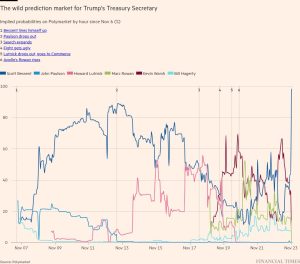A beginner’s guide to US earnings season
My favourite social media meme of the week — as the best ones always do — nailed on the noggin why I have no European stocks in my portfolio. Also why I yearn to invest in US companies once again.
It shows a montage of all the mind-blowing news from the US recently. Robotaxis and catching a 3,700 tonne rocket with chopsticks. OpenAI’s mega private capital raise. Nvidia’s almost $3.5tn equity value.
Then, Europe’s achievements: plastic bottles with those annoying new tops that cannot be removed. Yup, Brussels has been busy helping the fishes (and my dry cleaners thanks to all the orange juice I’ve spilled).
Funny, but harsh. European legislators are global leaders in artificial intelligence regulation. And their mandatory climate-risk and ESG-related reporting requirements for every firm with more than three employees and a dog are second to none.
But I don’t want to own companies burdened by nonsense such as the new corporate sustainability due-diligence directive (CSDDD), the task force on climate-related financial disclosures (TCFD), or the corporate sustainability reporting directive (CSRD).
Especially when US managers are free to actually change the planet while creating the wealth in order to do so. Exactly how much wealth investors will discover again over the coming weeks, as third-quarter results move into full gear.
I haven’t written about reporting seasons before. Now is a good time. With the S&P 500 approaching its 50th all-time high of the year, much is at stake. This column mostly advises equity holders not to fret — about interest rates, geopolitics, whatever.
Earnings, however, matter. But not always how you would expect. Think about what happens when Apple or Hung Poo (a Taiwanese real estate company) announce their results. They can be above, below or in line with previous numbers, but also market expectations.
Historical figures don’t move, whereas earnings estimates — company guided or analyst forecasts — change frequently. Before the US season began last Friday, 4.3 per cent growth versus last year was expected. Back in the summer it was 7 per cent, based on FactSet data.
But growth expectations do not seem to affect share prices much at all. Indeed, according to research by Axa Investment Managers, global stocks with the highest levels of expected growth actually underperform.
No, what matters is the reported (or “realised” in finance jargon) rise or fall in earnings. More still whether they have surprised the market. Over the past 25 years, Axa’s data shows that even the slowest-growing companies beat the index if they surprise on the upside. But the top growers don’t if they disappoint.
Therein lies the power of the US stock market, which has added almost another $10tn to its market cap so far in 2024. Year in, year out, it delivers aggregate earnings in excess of expectations. When I started in asset management 30 years ago, S&P 500 companies made $35 per share. This year, $250 is possible.
What about this quarter? There are reasons to believe they will over-deliver once again. Just ask them, in fact. Whereas forecast earnings growth is barely more than 4 per cent — which would mean the weakest results in a year — company guidance is 16 per cent, according to Bloomberg data.
That suggests many happy surprises ahead, perhaps mirroring the first three quarters of the year, when consensus was for 3.8 per cent growth, yet results were twice that. (Looking at my screens now, a tenth of S&P 500 companies have reported and three-quarters have positively surprised.)
On the other hand there are also worrying signs for those of us who would like earnings to flop so we can buy in. Pre-results season, Citigroup’s earnings revision index, for example, was the most negative since the end of 2022.
Which also makes next year’s consensus forecast of 14 per cent growth all the more extreme — especially as achieving this would make the post-Covid average 9 per cent per annum. Over the past three dozen years the S&P’s annual earnings per share (EPS) growth rate is 6.6 per cent.
And I’m not alone feeling nervous. Just this month, short positions against the popular SPDR exchange traded fund that tracks US shares have doubled as a percentage of its outstanding shares, based on HIS Markit numbers.
So we all need to be on Surprise Watch over the coming weeks. In the past decade, the S&P 500 has smashed estimates by an average of almost 7 per cent and has generally surprised on the upside in 37 of the past 40 quarters.
Are there other quirks to US earnings season that investors should know? Behavioural wonks may be amused by a Journal of Financial Economics paper which shows that the day of the week that companies report influences subsequent share price returns.
More concerning is a study from 2021 that revealed a rising trend in positive earnings surprises due to companies increasingly publishing — and then beating — adjusted profits. Indeed, this reflects a broader trend of reported figures diverging from official US national accounts data.
Results are fiddled, in other words. Not including the amortisation of intangible assets is always popular, as is excluding litigation expenses (no matter how frequent). A Calcbench analysis found that the average EPS uplift versus standard accounting practice was almost 30 per cent last year.
But no one seems bothered that reported earnings are a fiction. After all, businesses still have to beat the previous quarterly number, similarly massaged. It’s worth pondering, though, when assessing valuation multiples.
This is why I remain underweight. Yes, US companies generate earnings like no others. I just reckon that at the moment this ability is more than in the price — and some. Few agree with me.
The author is a former portfolio manager. Email: [email protected]; Twitter: @stuartkirk__
#beginners #guide #earnings #season





